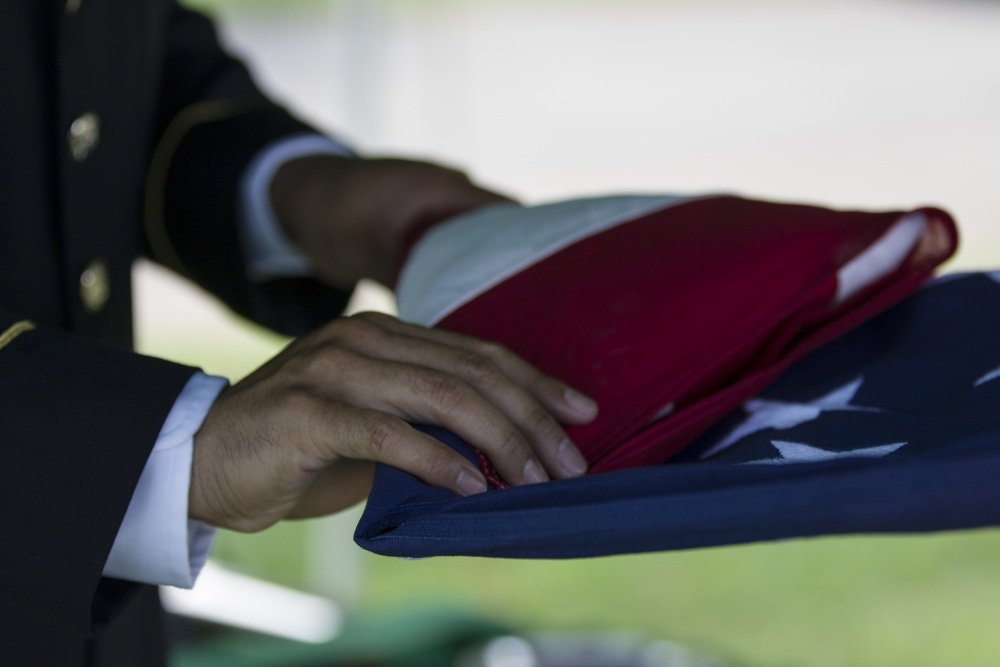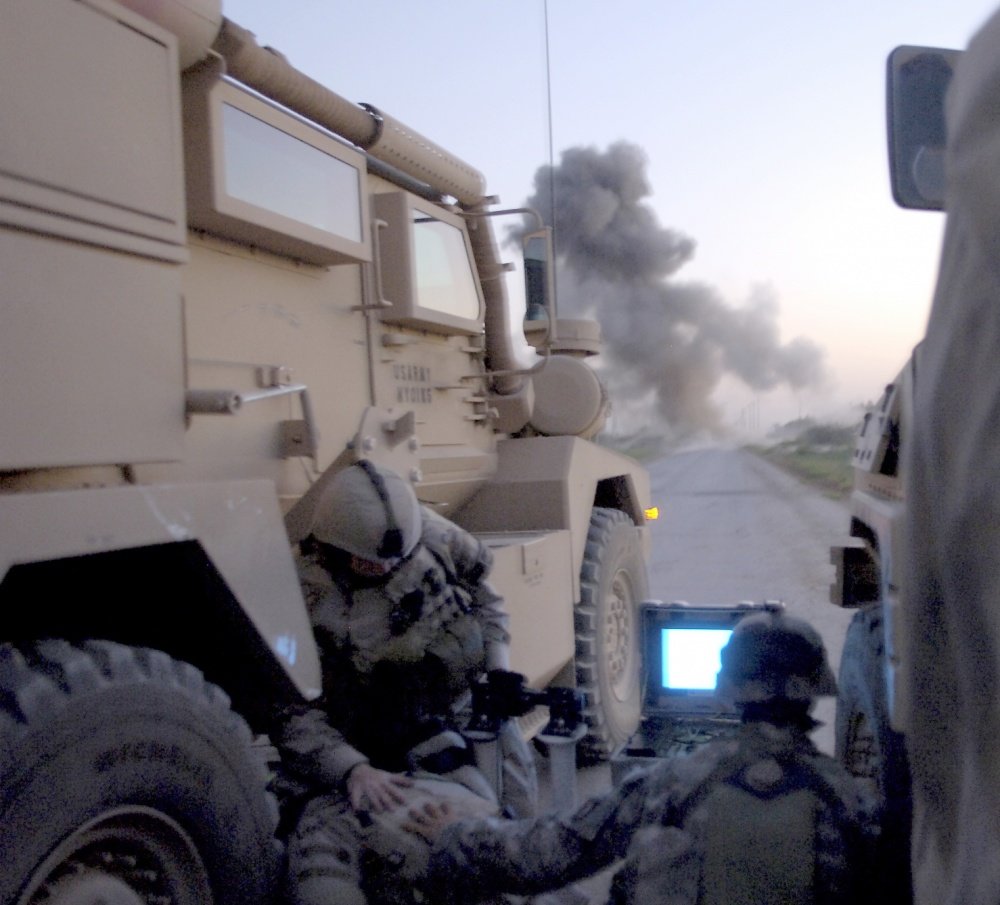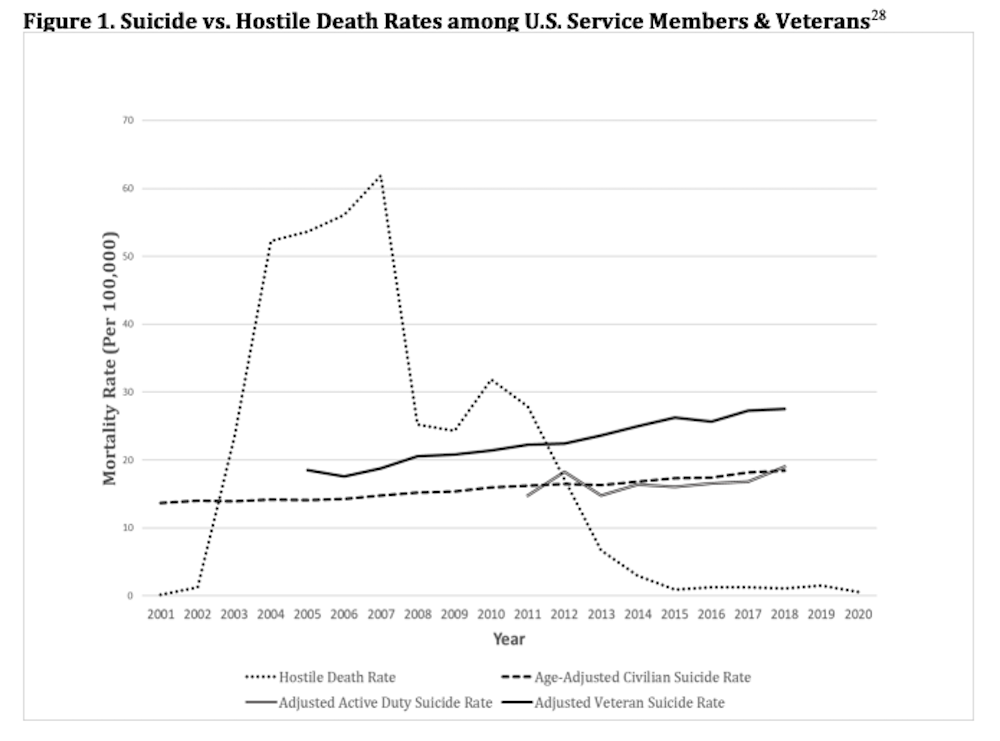
A soldier folds a flag during a military funeral honors ceremony. A recent Brown University report concludes that suicides among veterans and National Guard soldiers continue to rise. US Army photo by Sgt. Rakeem Carter, courtesy of DVIDS.
A report released Monday by Brown University’s Cost of War Research Series estimates that 30,177 active-duty personnel and veterans have committed suicide since the beginning of the Global War on Terror, compared to the more than 7,000 combat deaths. According to the report, veterans — particularly those exposed to improvised explosive devices — along with members of the National Guard, are taking their own lives at an alarming rate.
According to the report, traumatic brain injuries (TBI) have affected as many as 20% of post-9/11 service members, with the injury being prevalent enough to be deemed the “signature injury” of the conflicts in Iraq and Afghanistan. Researchers found that suffering a TBI increases a service member’s risk of suicide, with each additional TBI continuing to raise the risk.

While the actual rate is still being determined, and the report states that the correlation between TBI and suicides warrants additional study, environmental factors associated with both IEDs and blast injuries appear severe.
According to the report, the persistent use of IEDs by insurgents, which accounted for more than half of the casualties early in the GWOT, contributes to a “constant state of fear and vulnerability,” which increases the “operational stress burden” on those overseas. Overall, this combination has been linked to a 26% increase in suicidal behaviors by active-duty personnel.
“The association affects early career servicemembers more, suggesting the fear of threat places a persistent burden and stress on combatants and may lead to psychosocial stress and burnout,” the report states.

The Department of Veterans Affairs states that the suicide rate among veterans is 1.5 times higher than the rate among the general population. Absent from this count are veterans of the National Guard and reserves who strictly served stateside and were not federally activated under Title 10 orders. Even without those service members in the count, the current actual rate is 27.5 per 100,000. By comparison, the report cites a rate of 18 per 100,000 for the general population.
Additionally, with veterans ages 18 to 34, suicides have increased by 76% since 2005. For post-9/11 veterans, those in the 18 to 34 age group have been hit the hardest, with rates of suicide skyrocketing from 32.3 per 100,000 between 2005 and 2017 to 45.9 per 100,000 in 2018. The most recent data shows a suicide rate of 45.9 among veterans 18 to 34 — about 2.5 times the general population.

A final strikingly high suicide rate is present in the National Guard. According to the report, the suicide rate among reservists is about the same as both active-duty members and the public. However, the most recent data from the National Guard showed that members took their lives at a rate of 30.6 per 100,000.
Overall, the Brown University report illustrates that suicides by veterans continue to grow, despite the billions spent trying to stem the tide.
“Unless the U.S. government and U.S. society makes significant changes in the ways we manage the mental health crisis among our service members and veterans, suicide rates will continue to climb. That is a cost of war we cannot accept,” the report concludes.
Read Next: Learning To Live in the World — On Suicide, Surviving, and Saving Others

James Webb served as a US Marine infantryman from 2005 to 2010, completing a combat tour in Iraq. He’s worked as a freelance writer and photojournalist covering US troops in Afghanistan, and Webb spent more than two years in the US Senate as a military legislative assistant and as the personal representative of a member on the US Senate Foreign Relations Committee.
BRCC and Bad Moon Print Press team up for an exclusive, limited-edition T-shirt design!
BRCC partners with Team Room Design for an exclusive T-shirt release!
Thirty Seconds Out has partnered with BRCC for an exclusive shirt design invoking the God of Winter.
Lucas O'Hara of Grizzly Forge has teamed up with BRCC for a badass, exclusive Shirt Club T-shirt design featuring his most popular knife and tiomahawk.
Coffee or Die sits down with one of the graphic designers behind Black Rifle Coffee's signature look and vibe.
Biden will award the Medal of Honor to a Vietnam War Army helicopter pilot who risked his life to save a reconnaissance team from almost certain death.
Ever wonder how much Jack Mandaville would f*ck sh*t up if he went back in time? The American Revolution didn't even see him coming.
A nearly 200-year-old West Point time capsule that at first appeared to yield little more than dust contains hidden treasure, the US Military Academy said.












